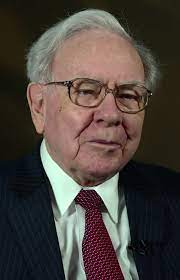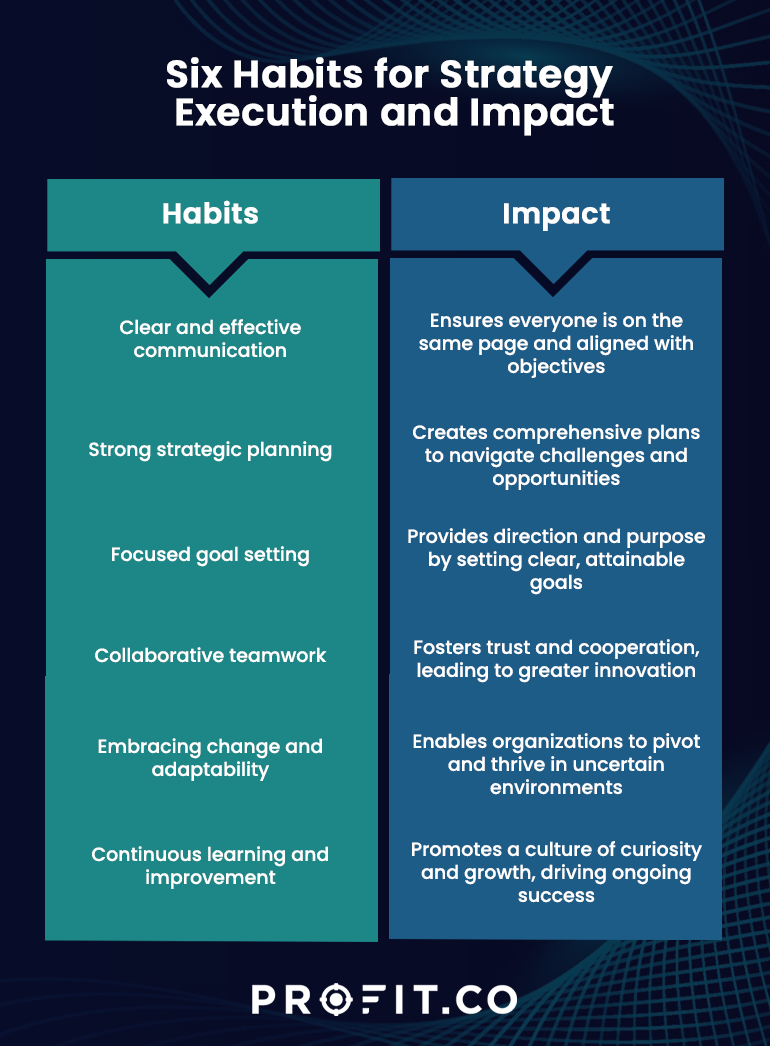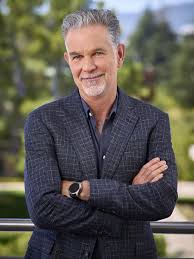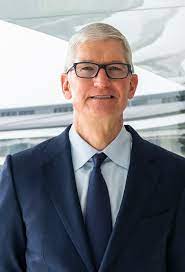In today’s fast-paced and competitive business environment, successful strategy execution is crucial for organizations to stay ahead of the curve. However, effective strategy execution requires strong leadership. This blog post will explore six habits consistently exhibited by successful strategy execution leaders. Understanding and adopting these habits can improve your leadership skills and drive your organization toward success.
From Planning to Execution: Leadership Habits That Get Results
| Six Habits for strategy execution | Impact on Strategy Execution |
Leader |
|---|---|---|
| Clear and Effective Communication | Ensures everyone is on the same page and aligned with objectives | Sara Blakely – Emphasizes an organization having a culture of communication and support |
| Strong Strategic Planning | Creates comprehensive plans to navigate challenges and opportunities | Indra Nooyi – Developed “Performance with Purpose” plan for PepsiCo |
| Focused Goal Setting | Provides direction and purpose by setting clear, attainable goals | Warren Buffet – Sets long term goals and allows small changes to compound over time |
| Collaborative Teamwork | Fosters trust and cooperation, leading to greater innovation | Satya Nadella – Shifted Microsoft’s focus to collaboration and teamwork |
| Embracing Change and Adaptability | Enables organizations to pivot and thrive in uncertain environments | Reed Hastings – Guided Netflix through multiple significant shifts |
| Continuous Learning and Improvement | Promotes a culture of curiosity and growth, driving ongoing success | Tim Cook – Keeps a strong group of advisors and encourages continuous learning by example |
Habit 1: Clear and Effective Communication
Successful strategy execution leaders understand the importance of communication in translating their vision into actionable steps for their teams. They are skilled at articulating complex ideas in simple, understandable terms and actively listen to effective feedback from team members.
For example, such leaders may use town hall meetings, regular team updates, and one-on-one sessions to ensure everyone is on the same page. They also leverage collaboration tools like Slack or Microsoft Teams to facilitate ongoing communication and information sharing. By fostering an environment of open dialogue, these leaders can address concerns and align their teams toward common objectives.

Habit 1: Clear and Effective Communication – Sara Blakely
Entrepreneur and inventor Sara Blakely became the youngest self-made billionaire in 2012 through her invention of Spanx. Blakely found a gap in the market for women’s shapewear after and created her prototype with an initial investment of only $5,000 while working as a door-to-door fax machine saleswoman. In recent years, Blakely has made headlines for her outstanding leadership.
In a MasterClass seminar she taught, Blakely explained that prioritizing a culture fit with a robust support system is the reason for her success. Creating a strong community is a priority at Spanx, with Blakely even gifting her 500 employees two first-class tickets and $10,000 for a dream vacation to extend appreciation and celebrate her employees’ dedication to the company.
Habit 2: Strong Strategic Planning
Effective leaders recognize that thorough planning is essential for strategy execution. They invest time in developing comprehensive strategic plans, which include clearly defined objectives, milestones, and contingencies. They also regularly review and update these plans to stay current with evolving market conditions and organizational needs.
For instance, successful strategy execution leaders may use SWOT analysis, scenario planning, or other planning methodologies to outline potential challenges and opportunities. They also engage key stakeholders in planning, ensuring that diverse perspectives are considered and incorporated into the plan.

Habit 2: Strong Strategic Planning – Indra Nooyi
Indra Nooyi, the former CEO of PepsiCo, demonstrated strong strategic planning abilities during her tenure. Nooyi’s “Performance with Purpose” plan transformed PepsiCo by shifting the company’s focus towards healthier products, environmental sustainability, and employee Well-being. Her strategic vision allowed PepsiCo to remain competitive and profitable in a rapidly changing market.
Habit 3: Focused Goal Setting
Successful strategy execution leaders set clear, attainable, and measurable goals that align with their strategic plans. They prioritize these goals and communicate their importance to the team, providing a sense of purpose and direction.
For example, leaders may use the SMART (Specific, Measurable, Achievable, Relevant, and Time-bound) framework to develop well-defined goals. They also employ tools like Key Performance Indicators (KPIs) and Objectives and Key Results (OKRs) to track progress and ensure that goals are met on time.
Ready to start your OKR journey today?

Habit 3: Focused Goal Setting – Warren Buffet
Warren Buffet, the famous investor, is known for his patience. The current chairman and CEO of Berkshire Hathaway has a true rags-to-riches story, with his humble roots stemming from Omaha, Nebraska.
His long-term investments have made billions. Known for being steadfast and practical with his business endeavors, Buffet creates goals that compound over time instead of overly ambitious ones. Like the market, small changes over a long period gain momentum and are incredibly effective in a business. Buffet has mastered the art of sustainable growth at Berkshire Hathaway by setting clear and attainable goals.

Habit 4: Collaborative Teamwork
Strong leaders understand the power of teamwork in executing strategies effectively. They foster a collaborative environment where team members feel comfortable sharing ideas, providing feedback, and supporting one another.
To build trust and collaboration, successful strategy execution leaders may use team-building exercises, regular check-ins, and cross-functional projects. They also promote a culture of inclusivity and diversity, which encourages different perspectives and drives innovation.

Habit 4: Collaborative Teamwork – Satya Nadella
Microsoft CEO Satya Nadella has fostered a culture of collaborative teamwork since taking the helm in 2014. Nadella shifted Microsoft’s focus from competition to collaboration internally and with external partners. This approach enabled Microsoft to pivot to cloud computing, AI, and other emerging technologies, revitalizing the company and driving sustained growth.
Listening was the most important thing I accomplished each day because it would build the foundation of leadership for years to come.
Habit 5: Embracing Change and Adaptability
In the face of change, successful strategy execution leaders display adaptability and resilience. They are willing to alter their plans and strategies when necessary, and they inspire their teams to be adaptable as well.
For instance, these leaders may adopt agile methodologies or use change management principles to guide their teams through periods of uncertainty. They also communicate the rationale behind changes and provide support to help team members adjust and thrive in new circumstances.

Habit 5: Embracing Change and Adaptability – Reed Hastings
Netflix co-founder, and former CEO Reed Hastings, has consistently demonstrated adaptability throughout the company’s history. Under his leadership, Netflix has successfully navigated multiple significant shifts, including transitioning from DVD rentals to streaming and later expanding into original content production.
Hastings claimed his motivation to turn Netflix into a powerhouse stems from a $40 Blockbuster fee he received and the determination to change the landscape for renting content. He concocted a plan where consumers could rent videos like a gym membership, with a flat fee and unlimited choices. Hastings’ willingness to embrace change and adapt the business model quickly has been a driving force behind Netflix’s continued success.
Habit 6: Continuous Learning and Improvement
Effective strategy execution leaders are committed to ongoing learning and improvement, both for themselves and their teams. They encourage a culture of curiosity and experimentation, embracing failures as opportunities for growth.
Successful leaders may provide access to training programs, workshops, or mentorship opportunities to promote continuous improvement. They also lead by example, seeking feedback and remaining open to learning from their own experiences and those of others.

Habit 6: Continuous Learning and Improvement – Tim Cook
Apple CEO Tim Cook is a fantastic listener. During presentations and panel discussions, he redirects questions to other staff members, limiting his speaking time. Cook’s philosophy is to surround yourself with trusted advisors and to learn from their input. Having experts in every department allows employees to expand their learning. Apple is known for innovation, which Cook encourages through curiosity and modeling continuous learning.
Conclusion
Successful strategy execution leaders exhibit six key habits: clear and effective communication, strong strategic planning, focused goal setting, collaborative teamwork, embracing change and adaptability, and continuous learning and improvement. Understanding and adopting these habits can improve your leadership capabilities and position your organization for success. Remember, leadership is an ongoing journey, and there is always room for growth. Embrace these habits and invest in your personal and professional development to become the strategy execution leader your organization needs. The road to success is paved with dedication, adaptability, and a commitment to continuous improvement.

